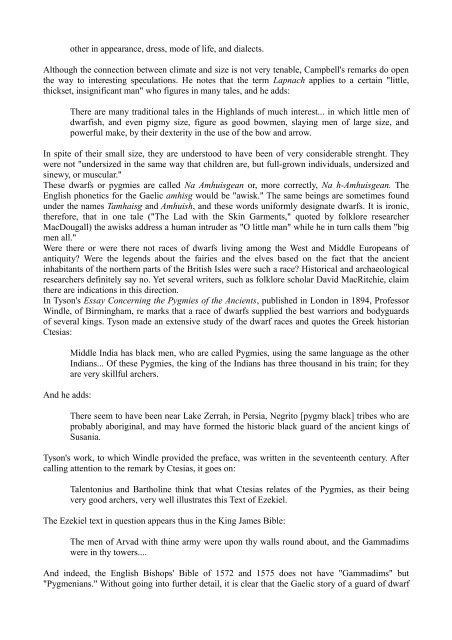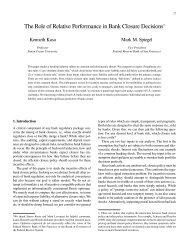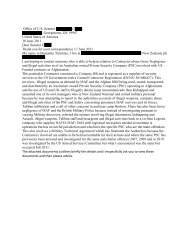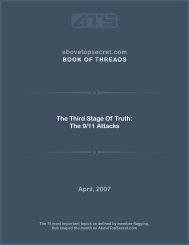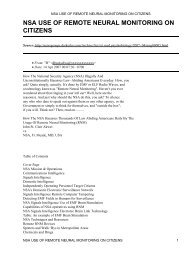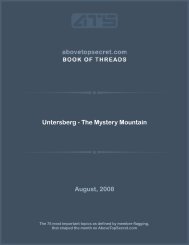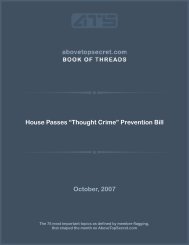other in appearance, dress, mode <strong>of</strong> life, and dialects.Although the connection between climate and size is not very tenable, Campbell's remarks do openthe way to interesting speculations. He notes that the term Lapnach applies to a certain "little,thickset, insignificant man" who figures in many tales, and he adds:There are many traditional tales in the Highlands <strong>of</strong> much interest... in which little men <strong>of</strong>dwarfish, and even pigmy size, figure as good bowmen, slaying men <strong>of</strong> large size, andpowerful make, by their dexterity in the use <strong>of</strong> the bow and arrow.In spite <strong>of</strong> their small size, they are understood to have been <strong>of</strong> very considerable strenght. Theywere not "undersized in the same way that children are, but full-grown individuals, undersized andsinewy, or muscular."These dwarfs or pygmies are called Na Amhuisgean or, more correctly, Na h-Amhuisgean. TheEnglish phonetics for the Gaelic amhisg would be "awisk." The same beings are sometimes foundunder the names Tamhaisg and Amhuish, and these words uniformly designate dwarfs. It is ironic,therefore, that in one tale ("The Lad with the Skin Garments," quoted by folklore researcherMacDougall) the awisks address a human intruder as "O little man" while he in turn calls them "bigmen all."Were there or were there not races <strong>of</strong> dwarfs living among the West and Middle Europeans <strong>of</strong>antiquity? Were the legends about the fairies and the elves based on the fact that the ancientinhabitants <strong>of</strong> the northern parts <strong>of</strong> the British Isles were such a race? Historical and archaeologicalresearchers definitely say no. Yet several writers, such as folklore scholar David MacRitchie, claimthere are indications in this direction.In Tyson's Essay Concerning the Pygmies <strong>of</strong> the Ancients, published in London in 1894, Pr<strong>of</strong>essorWindle, <strong>of</strong> Birmingham, re marks that a race <strong>of</strong> dwarfs supplied the best warriors and bodyguards<strong>of</strong> several kings. Tyson made an extensive study <strong>of</strong> the dwarf races and quotes the Greek historianCtesias:And he adds:Middle India has black men, who are called Pygmies, using the same language as the otherIndians... Of these Pygmies, the king <strong>of</strong> the Indians has three thousand in his train; for theyare very skillful archers.There seem to have been near Lake Zerrah, in Persia, Negrito [pygmy black] tribes who areprobably aboriginal, and may have formed the historic black guard <strong>of</strong> the ancient kings <strong>of</strong>Susania.Tyson's work, to which Windle provided the preface, was written in the seventeenth century. Aftercalling attention to the remark by Ctesias, it goes on:Talentonius and Bartholine think that what Ctesias relates <strong>of</strong> the Pygmies, as their beingvery good archers, very well illustrates this Text <strong>of</strong> Ezekiel.The Ezekiel text in question appears thus in the King James Bible:The men <strong>of</strong> Arvad with thine army were upon thy walls round about, and the Gammadimswere in thy towers....And indeed, the English Bishops' Bible <strong>of</strong> 1572 and 1575 does not have "Gammadims" but"Pygmenians." Without going into further detail, it is clear that the Gaelic story <strong>of</strong> a guard <strong>of</strong> dwarf
warriors is not an isolated case.If we return now to David MacRitchie's quotation from the Flemish folklore journal Ons Volksleven,we can learn more:The Fenlanders (a race dwelling in our country prior to the Kelts) were little, but strong,dexterous, and good swimmers, they lived by hunting and fishing. Adam <strong>of</strong> Bremen in theeleventh century thus pictures their descendants or race: "They had large heads, flat faces,flat noses, and large mouths. They lived in caves <strong>of</strong> rocks, which they quitted in thenighttime for the purpose <strong>of</strong> committing sanguinary outrages." The Keltic people, and laterthose <strong>of</strong> German race, so tall and strong, could hardly look upon such little folk as humanbeings. They must have regarded them as strange, mysterious creatures. And when thesenegroes or Fenlanders had lived for a long enough time hidden, for fear <strong>of</strong> the new people,in their grottoes, especially when they at lenght fell into decay through poverty, or died out,they became changed in the imagination <strong>of</strong> the dreamy Germans into mysterious beings, akind <strong>of</strong> ghosts or gods.In a footnote, MacRitchie states that he is "not aware on what grounds this author speaks <strong>of</strong> them asblack people," but he admits that these dwarfish Fenlanders might be regarded as the originals <strong>of</strong>the awisks <strong>of</strong> the Gaelic legend.A tradition in the Orkney Isles <strong>of</strong>fers a parallel to the above story. Sometime in the first part <strong>of</strong> thefifteenth century, Bishop Thomas Tulloch <strong>of</strong> Orkney gave details, in De Orcadibus Insulis, <strong>of</strong> thetradition that the archipelago had been inhabited six centuries earlier by the Papae and a race <strong>of</strong>dwarfs. The Papae were the Irish priests. And the dwarfs were the Picts. In this, MacRitchie followsBarry's Orkney, where we read:They are plainly no other than the Peiths, Picts, or Piks.... The Scandinavian writersgenerally call the Piks Peti, or Pets: one <strong>of</strong> them uses the term Petia, instead <strong>of</strong> Pictland(Saxo-Gram.); and besides, the firth that divides Orkney from Caithness is usuallydenominated Petland Fiord in the Icelandic Sagas <strong>of</strong> histories.The consistency running through these ancient accounts, MacRitchie says, is indeed remarkable.The Irish priests followed St. Columba, who himself was a great-grandson <strong>of</strong> Conall Gulban, who,tradition states, had fierce battles with a race <strong>of</strong> dwarfs. Conall Gulban's fights with the dwarfsindeed are the origin <strong>of</strong> a series <strong>of</strong> tales sometimes attributed to other legendary heroes. If we try toget as close as possible to the original story, this is what we get:According to J. F. Campbell <strong>of</strong> Islay, Conall Gulban was the son <strong>of</strong> the famous Neil, the ancestor <strong>of</strong>the O'Neills <strong>of</strong> Ulster. He was the great-grandfather <strong>of</strong> St. Columba. His adventures begin in thenorthwest <strong>of</strong> Ireland, "somewhere in the dawn <strong>of</strong> the fifth century." After various experiences,Gulban landed in the "realm <strong>of</strong> Lochlann," generally believed to be Scandinavia, which itself had arather vague meaning at the time. There Gulban was intrigued by a strange construction and askedhis guide: "What pointed house is there?""That is the house <strong>of</strong> the Tamhaisg, the best warriors that are in the realm <strong>of</strong> Lochlann," the guidereplied."I heard my grandfather speaking about the Tamhaisg," said Conall, "but I have never seen them. Iwill go to see them.""It were not my counsel to thee!" were the guide's last words.This advice, naturally, Conall Gulban disregarded. He went straight to the palace <strong>of</strong> the King <strong>of</strong>Lochlann and challenged him to combat. He was told, as recorded by Campbell <strong>of</strong> Islay:He should get no fighting at that time <strong>of</strong> night, but he should get lodging in the house <strong>of</strong> theamhusg (awisks), where there were eighteen hundred amhusg, and eighteen score.... Hewent, and he went in, and there were none <strong>of</strong> the amhuish within that did not grin. When he
- Page 3 and 4: Foreword by Whitley StrieberThere a
- Page 5 and 6: It is sad that, as the twentieth ce
- Page 7 and 8: PART ONE: THE ALIEN CHRONICLESIn th
- Page 9 and 10: lot about it, but nobody said 'Let'
- Page 11 and 12: The resemblance of the Dogu statues
- Page 13: various forms of error worship unde
- Page 16 and 17: them. These apparitions are scarce,
- Page 18 and 19: was again shot at. Another creature
- Page 20 and 21: The story is fantastic. Yet it remi
- Page 22 and 23: their virginity in the sanctuaries
- Page 24 and 25: A letter from a British woman begin
- Page 26 and 27: The recollections of the legionnair
- Page 28 and 29: lades. In less time than it takes t
- Page 30 and 31: e called Smith said: "No, we cannot
- Page 32 and 33: Celtic legends, along with the docu
- Page 34 and 35: probably took place in the second p
- Page 36 and 37: Australian Air Force Intelligence p
- Page 38 and 39: ings in the fields and prairies?One
- Page 40 and 41: From behind the object, two beings
- Page 42 and 43: "in smooth English." They did not s
- Page 44 and 45: to four feet tall, dressed in white
- Page 46 and 47: expectations as if they were mere t
- Page 48 and 49: came out of it, but this person was
- Page 50 and 51: 6. When men did not inhabit most of
- Page 52 and 53: the negative reactions of scientist
- Page 56 and 57: saw that they had made a grin, he h
- Page 58 and 59: and rode out after dark in search o
- Page 60 and 61: sighting, and the Sonny Desvergers
- Page 62 and 63: PART TWO: ANOTHER REALITYDuring the
- Page 64 and 65: pencil in a buttonhole with a piece
- Page 66 and 67: short perpendicular line on each en
- Page 68 and 69: sudden displacement of warm air or
- Page 70 and 71: popular today. But a second - and e
- Page 72 and 73: ecorded about 1825 in the Vale of N
- Page 74 and 75: The ikal of the Tzotzils flies thro
- Page 76 and 77: the door, he turned and recieved a
- Page 78 and 79: If Stewart came back today, he woul
- Page 80 and 81: The devil does not have a body. The
- Page 82 and 83: interested in the social implicatio
- Page 84 and 85: Very well, little son. Come back to
- Page 86 and 87: measure. But the phenomenon does ap
- Page 88 and 89: and physical, to determine whether
- Page 90 and 91: previous year. But the fact remains
- Page 92 and 93: Do Not Report This!Accounts such as
- Page 94 and 95: least one occasion, experienced lev
- Page 96 and 97: deep unconscious level of the symbo
- Page 98 and 99: much as twenty hours a day, and in
- Page 100 and 101: against me as I stood bracing mysel
- Page 102 and 103: another one, but this was very defi
- Page 104 and 105:
not natural, was witnessed by perso
- Page 106 and 107:
The predicted miracle took place as
- Page 108 and 109:
The phenomenon, it seems, could not
- Page 110 and 111:
in the final analysis.Many of us wi
- Page 112 and 113:
already surrounded....I was told wh
- Page 114 and 115:
Since the publication of my earlier
- Page 116 and 117:
”A bright flash”Fatima, May 13,
- Page 118 and 119:
The Invisible CollegeAfter some thi
- Page 120 and 121:
the Air Force met in Dallas and dis
- Page 122 and 123:
panel of scientists could rapidly b
- Page 124 and 125:
it had been hovering there was now
- Page 126 and 127:
like piezo-electricity, or static e
- Page 128 and 129:
the group teachings and advice. The
- Page 130 and 131:
This is a frightening view, one tha
- Page 132 and 133:
John McCoy, who coauthored with Wil
- Page 134 and 135:
of reports about "the robots" and "
- Page 136 and 137:
eathe our air. They walked normally
- Page 138 and 139:
the designation Wolf 424.The myster
- Page 140 and 141:
a scar or a mark. The authorities w
- Page 142 and 143:
esearches might have a bearing on a
- Page 144 and 145:
me undeniable) and as psychic devic
- Page 146 and 147:
extraterrestrial theory is not stra
- Page 148 and 149:
the universe summarizes the problem
- Page 150 and 151:
About the AuthorAn astrophysicist b


